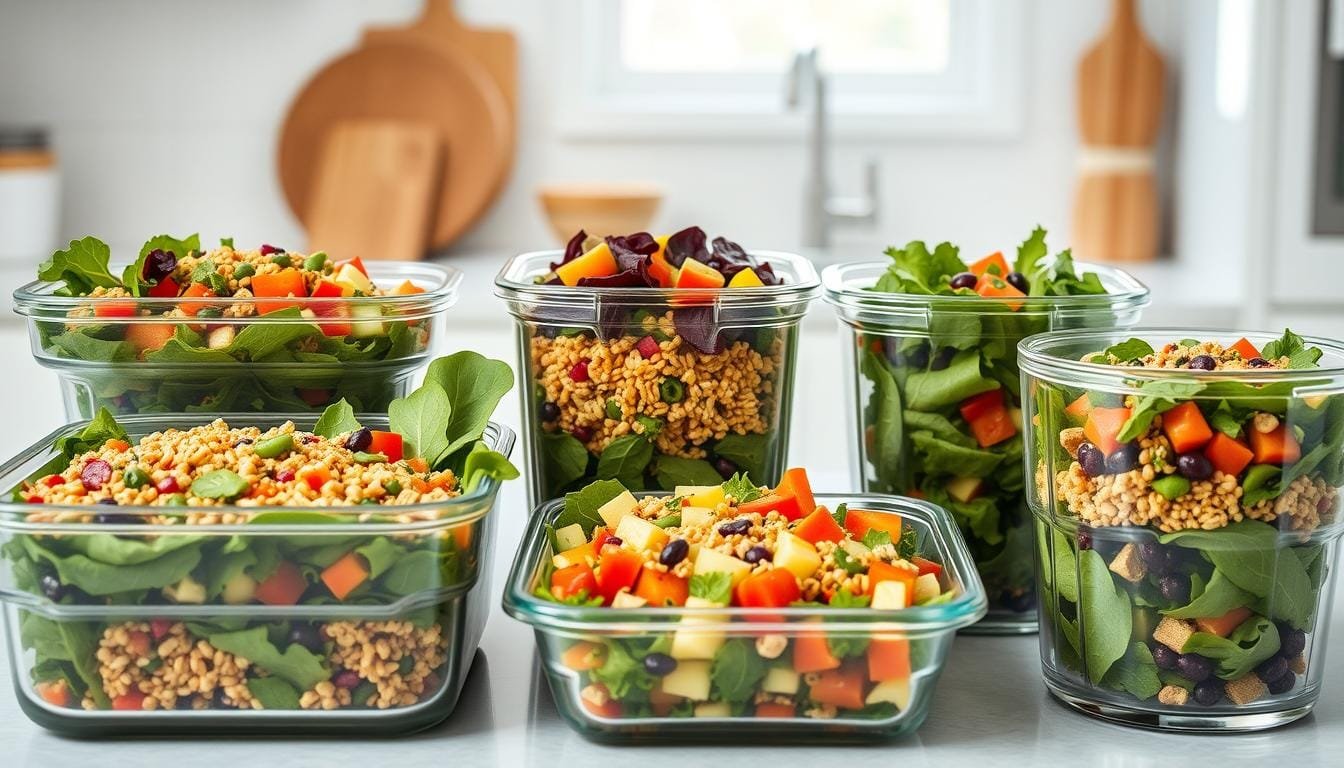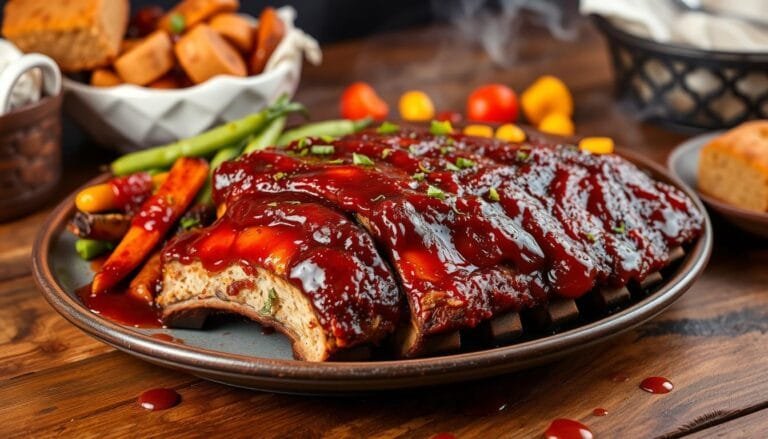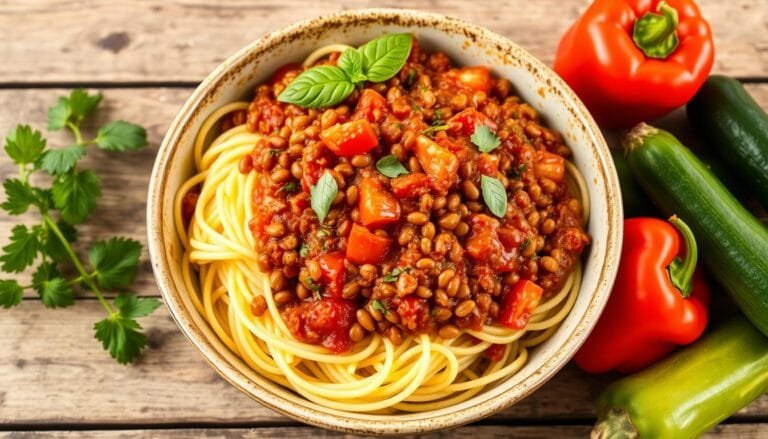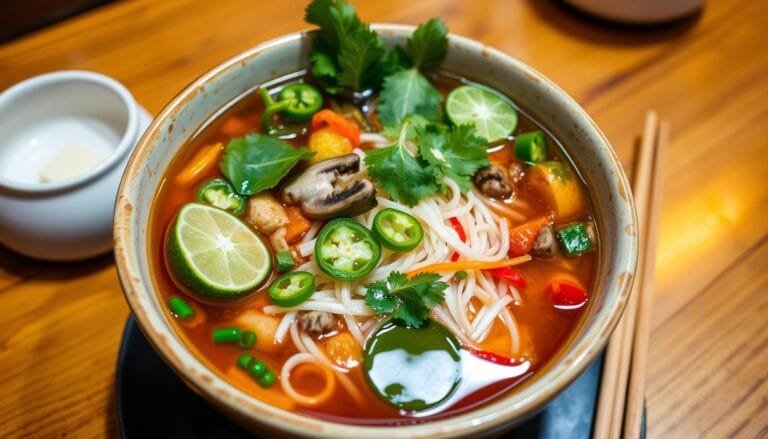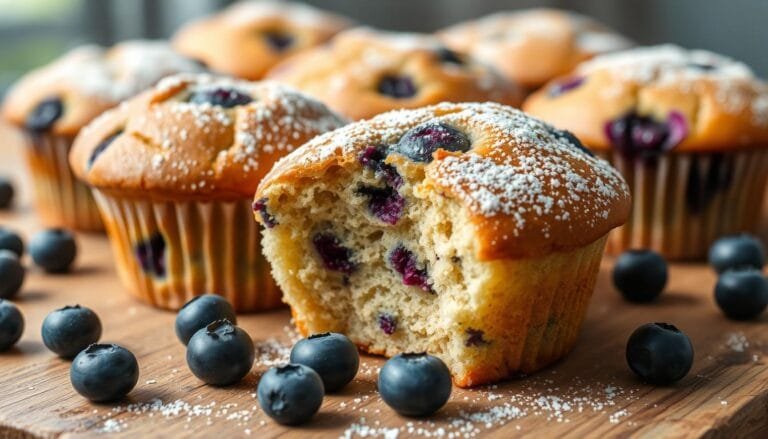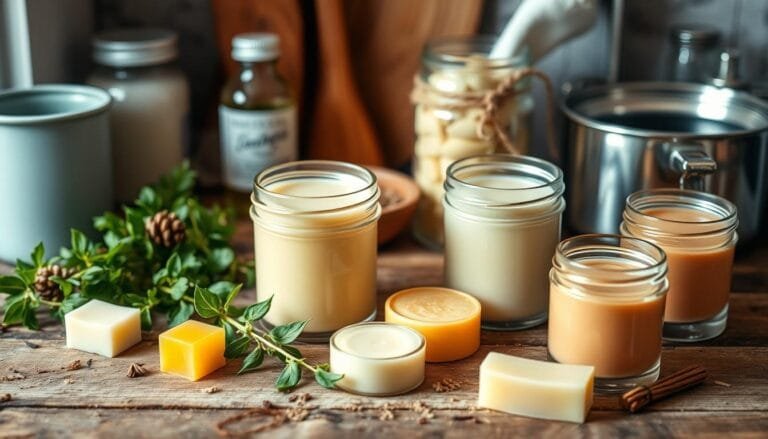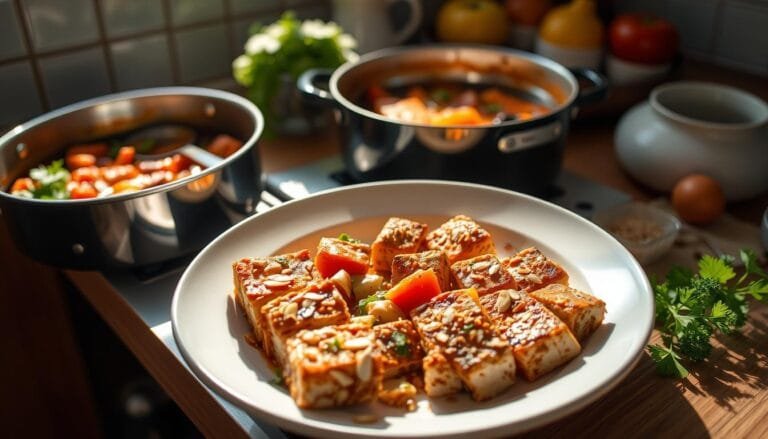As a busy professional, I know it’s tough to eat healthy during the week. That’s why I’m excited to share my favorite plant-based meal prep salad recipes. These salads are great for keeping you energized, whether you’re at work or busy with tasks.
These salad recipes are made to be prepared ahead of time. This makes it easy to have a quick, healthy lunch or snack. From BBQ soy curl and black bean salad to turmeric quinoa and edamame power bowl, they’re full of fresh ingredients and tasty dressings.
Whether you’re a pro at meal prep or new to plant-based cooking, these salads are perfect for busy days. You’ll enjoy a mix of flavors and textures while getting the nutrients your body needs.
Why meal prepping plant-based salads is a game-changer
Meal prepping plant-based salads can change your life if you’re always on the go. It saves you time and money, and boosts your health. Just a little effort upfront can make a big difference.
Time-Saving Benefits During Busy Weekdays
Having pre-made salads means you can skip the morning rush. Over seven years of experience in meal planning shows it saves a lot of time. You can then focus on other things you need to do.
Cost-Effective Meal Planning Advantages
Meal planning can reduce food waste by only buying what you need. This smart way of meal prepping helps you stick to your diet and save money. It makes your life more affordable and organized.
Health Benefits of Prepared Plant-Based Meals
Preparing plant-based salads ahead of time is good for your health. Meal planning framework that works for individuals transitioning to a new way of eating or with specific food goals, like eating more fruits and veggies, helps you eat better. It’s a smart way to invest in your health.
“Detailed planning can take less than 30 minutes once there is a curated list of inspirations,” explains a member of the Meal Plan Accountability Club (MPAC), which has been meeting for over two years.
Essential tools and containers for successful salad prep
Preparing delicious and nutritious plant-based salads for the week ahead requires the right tools and storage solutions. From measuring utensils to high-quality containers, having the essentials on hand can make all the difference. It streamlines your meal prep process. Let’s explore the key items that will transform your salad game and set you up for success.
Measuring Tools and Prep Essentials
- Precise measuring cups and spoons to ensure accurate portioning of ingredients
- A sharp chef’s knife and cutting board for efficient vegetable chopping and slicing
- A salad spinner to quickly and effectively dry your greens, saving valuable time
- A vegetable peeler for effortlessly removing skins and creating thin, uniform slices
Versatile Storage Containers
When it comes to salad prep, the right containers can make all the difference. They help preserve freshness and prevent spoilage. Consider these top-rated options:
- Mason jars for layered, grab-and-go salads that stay crisp and separated
- Meal prep containers with individual compartments to organize your ingredients
- Airtight, leak-proof food storage containers to lock in freshness and prevent spills
Dressings and Sauces
For drizzling over your salads, you’ll want smaller, dedicated containers. They keep your homemade dressings and sauces fresh and ready to go. Some excellent options include:
- 4-ounce mason jars for single-serve portions of your favorite dressings
- Hinge-top glass jars for easy pouring and storing larger batches of dressings
- Silicone squeeze bottles for precise, mess-free application of your signature sauces
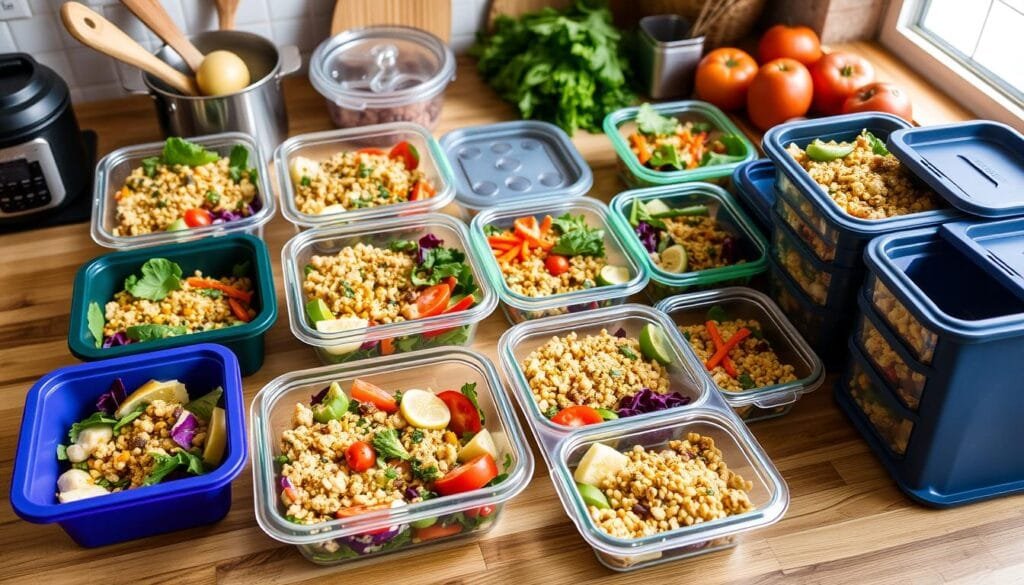
By investing in these essential tools and containers, you’ll be well on your way. You’ll be crafting delectable, long-lasting salads. These make healthy eating a breeze, even on your busiest days.
Plant-based meal prep salad recipes
Boost your meal prep with these tasty vegan salad recipes. They range from protein-rich bowls to Mediterranean flavors. These dishes add variety to your midweek meals.
BBQ Soy Curl and Black Bean Salad
This salad has rehydrated soy curls in BBQ sauce, with black beans, corn, cherry tomatoes, and red onion. It’s a nutritious and flavorful meal.
Turmeric Quinoa and Edamame Power Bowl
Try this nutrient-rich bowl with turmeric quinoa, edamame, red cabbage, bell peppers, and almond butter dressing.
Mediterranean Chickpea Mason Jar Salad
The Mediterranean Chickpea Mason Jar Salad is a great, portable option. It has chickpeas, veggies, and a tangy dressing in a jar.
These vegan salad recipes bring a variety of tastes, textures, and nutrients. They keep your meals exciting and healthy all week. Enjoy these protein-packed meals and flavorful plant-based dishes with ease.
Best ingredients for lasting freshness and crunch
Building a great salad starts with picking the right ingredients. Choose crisp vegetables and fruits for texture and freshness. These elements keep your salad crunchy and vibrant all week.
- Sturdy greens like kale, romaine, or cabbage are better than spinach or arugula.
- Crisp vegetables such as carrots, bell peppers, and cucumbers stay crunchy when stored right.
- Avoid pre-cutting watery ingredients like tomatoes or cucumbers to prevent sogginess.
- Add fruits like apples, grapes, or berries for a sweet crunch.
- Roasted veggies, such as sweet potatoes or Brussels sprouts, add a nice texture.
- Put crunchy toppings like nuts or seeds on just before eating to keep them crunchy.
Choosing the right ingredients makes your salad last longer and stay fresh. Enjoy the crunch and colors in every bite.
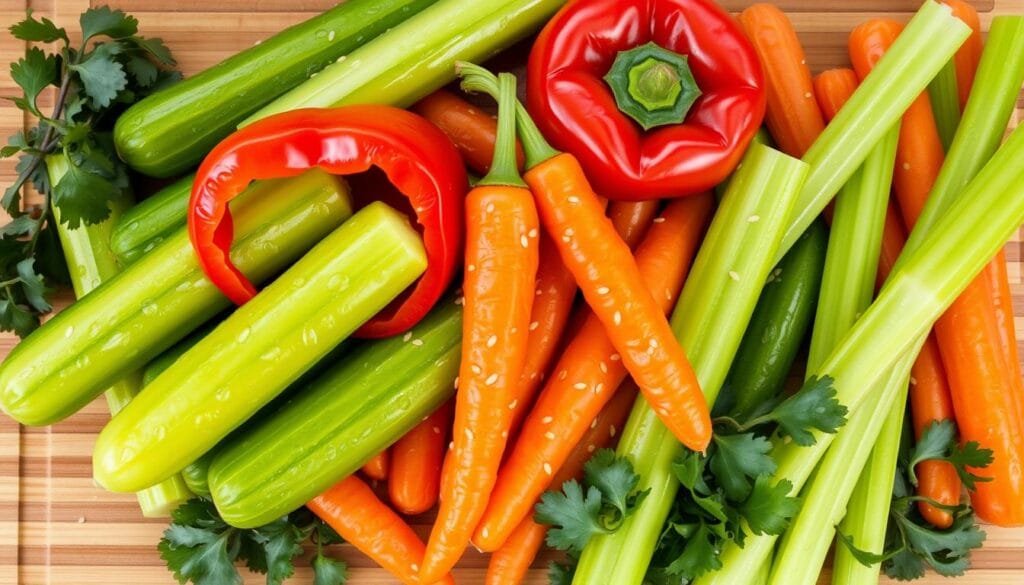
“The secret to a perfectly preserved salad is all in the ingredients. Sturdy greens, crunchy veggies, and a touch of sweetness from fruit – that’s the winning combination for a salad that stays fresh and vibrant all week long.”
Protein-rich plant-based ingredients for satisfying salads
Creating nourishing salads means adding protein-rich plant-based ingredients. Legumes, nuts, and seeds can turn a simple salad into a full meal. These ingredients make your salad complete and satisfying.
Legume Options for a Protein Boost
Legumes like chickpeas, black beans, lentils, and edamame are great for protein. A 1/2 cup of cubed tofu has 10 grams of protein. Beans such as black beans, kidney beans, and pinto beans are also high in protein.
Lentils, peas, and crushed peanuts are other protein-rich legume options. They add a lot of protein to your salads.
Nuts and Seeds Combinations
Adding nuts and seeds gives your salad a protein boost. Hemp seeds, pumpkin seeds, and peanuts are all high in protein. They add a nice crunch to your salads.
Walnuts, almonds, and chia seeds also add protein and healthy fats. They make your salad even more nutritious.
Plant-Based Protein Alternatives
Try plant-based alternatives like tofu, tempeh, seitan, and soy curls for different protein sources. These ingredients can be marinated, baked, or sautéed. They add texture and flavor to your salads.
Quinoa and other whole grains also add protein. They ensure your salad has all the amino acids you need.
Using a variety of protein-rich plant-based ingredients makes salads nutritious and satisfying. Try different combinations to find the perfect mix of flavors and textures. This way, you’ll enjoy a delicious and nourishing meal.
Creative dressings and sauces for meal prep salads
Adding excitement to your meal prep salads is all about the dressings and sauces. Instead of buying them, why not make your own? Homemade dressings are not only healthier but also more flavorful. Plus, you can tailor them to your taste.
Almond butter is a great base for creamy, vegan-friendly dressings. Mix it with plant-based milk, maple syrup, and a bit of citrus for a tasty topping. Tahini is also excellent, letting you create zesty Mediterranean dressings with garlic, lemon, and herbs.
For a nutrition boost, try an avocado-based dressing. Blend ripe avocado with fresh herbs, spices like turmeric or ginger, and vinegar. This creates a creamy, flavorful sauce that makes any salad better.
| Dressing | Key Ingredients | Nutrition (per 2 tbsp) |
|---|---|---|
| Apple Cider Vinegar | Apple cider vinegar, Dijon mustard, garlic, maple syrup | 84 calories, 5g fat, 5g carbs, 0g sugar, 2g fiber, 6g protein, 30mg sodium |
| Zesty Tahini | Tahini, lemon juice, water, garlic, spices | 87 calories, 9g fat, 2g carbs, 1g sugar, 0g fiber, 0g protein, 394mg sodium |
| Balsamic Vinaigrette | Balsamic vinegar, Dijon mustard, maple syrup, herbs | 103 calories, 9g fat, 5g carbs, 4g sugar, 0g fiber, 0g protein, 217mg sodium |
| Peanut Dressing | Peanut butter, soy sauce, rice vinegar, lime juice, sesame oil | 107 calories, 7g fat, 13g carbs, 6g sugar, 0g fiber, 3g protein, 345mg sodium |
| Honey Mustard | Dijon mustard, honey, apple cider vinegar, garlic | 106 calories, 9g fat, 7g carbs, 6g sugar, 0g fiber, 0g protein, 219mg sodium |
| Cilantro Lime | Cilantro, lime juice, olive oil, garlic, pepper | 163 calories, 18g fat, 1g carbs, 0g sugar, 0g fiber, 0g protein, 434mg sodium |
Homemade salad dressings and vegan sauces are fantastic because you can make them in big batches. Store them separately from your salads. This way, you can add a burst of flavor just before serving. Your greens will stay crisp and crunchy. Try using citrus juices, herbs, spices, and oil-free options like pureed fruits or vegetables as bases.
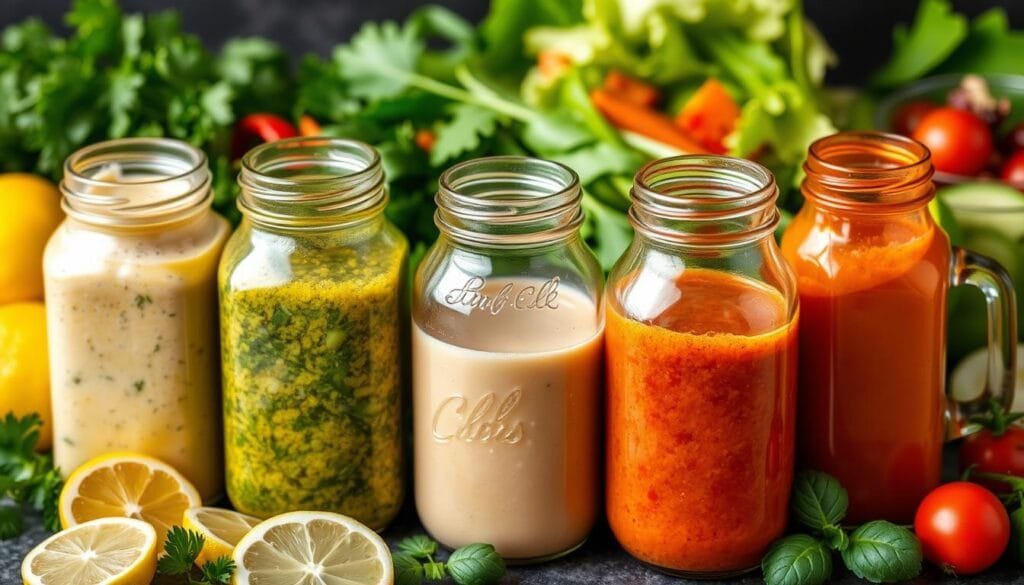
With a bit of creativity, your meal prep salads can become truly special. Homemade dressings and sauces offer endless possibilities. They let you customize flavors while keeping your meals healthy and tasty.
Storage tips and shelf life guidelines
Keeping your plant-based meal prep salads fresh and safe is key. By using a few simple storage tips, your salads will stay crisp and flavorful all week. This makes meal prep a breeze.
Proper Layering Techniques
When you put your salad together, layering is important. Start with dressings or sauces at the bottom. This keeps your greens from getting soggy.
Then, add your protein, grains, and veggies. Finish with the leafy greens on top. This keeps your salad crunchy and full of texture.
Temperature Control Recommendations
Food safety is critical when storing salads. Refrigerate them quickly, keeping the temperature below 40°F (4°C). This stops harmful bacteria from growing.
Use airtight containers to keep your salads fresh. This also prevents cross-contamination.
Container Organization Methods
Label your salad containers with what’s inside and the “eat-by” date. This makes it easy to know which salads to eat first. It also helps reduce food waste.
Organize your containers by their expiration dates. Place the earliest ones in the front for easy access. With these tips, your salads will stay fresh for 3-5 days.
Quick assembly techniques for busy mornings
Mornings can be chaotic, but you can make delicious, healthy plant-based salads even when you’re in a rush. The secret to quick meal prep is to prepare as much as you can ahead of time. Chop your ingredients in bulk and store them in separate containers for easy assembly later.
Use divided containers to keep your salad parts – like greens, veggies, proteins, and toppings – separate until you’re ready to mix them. This method saves time and keeps your salad fresh and crunchy.
- Pre-portion your dressings in small containers or reusable pouches for easy grab-and-go access.
- Create an assembly line system to efficiently prepare multiple salads at once. This allows you to streamline the process and save precious time on busy mornings.
- Keep a variety of pre-chopped vegetables and cooked plant-based proteins on hand for mix-and-match options. This gives you the flexibility to customize your salads based on your cravings or dietary needs.
- Consider partially assembling your salads the night before, leaving just the dressing and any delicate toppings to add in the morning. This “pre-prep” can shave valuable minutes off your morning routine.
With these efficient meal prep techniques, you can enjoy wholesome, grab-and-go plant-based salads even on your most time-crunched mornings. Embrace the power of efficient meal prep and time-saving tips to start your day off right, every time.

“Meal prepping has been a game-changer for my busy lifestyle. It’s amazing how much time and stress it saves me during the week.”
Seasonal ingredient variations for year-round prep
Meal prepping plant-based salads is fun because you can change recipes with the seasons. As the seasons change, I get to try new flavors. In spring, I add asparagus, peas, and strawberries to my salads.
Summer brings juicy tomatoes, crisp cucumbers, and sweet stone fruits. Autumn is for roasted squash, apples, and pears. And in winter, I use hearty root vegetables, citrus, and leafy greens.
Using seasonal produce makes my salads taste better and supports sustainable eating. It keeps my meal prep interesting. I suggest trying different ingredients based on what’s in season.
This way, I can enjoy tasty salads all year. It saves money, reduces waste, and lets me enjoy the best of each season. So, let the seasons guide your next meal prep – your taste buds and wallet will appreciate it!
